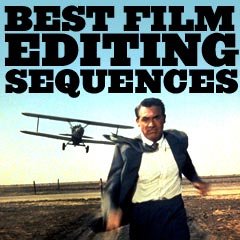
|
| Film Title/ Director & Editor and Film Description | ||
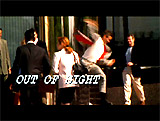
|
Out of Sight (1998) d. Steven Soderbergh
This crime caper contained a well-known, teasingly-filmed and edited, cross-cutting (or inter-cutting) sequence between convicted two of its characters:
First, they were conversing in a Detroit hotel bar-lounge and sharing a drink ("I like your hair, I like your outfit"), while they flirtatiously called each other different alias names, Gary and Celeste. He explained how they were destined to be together:
Minutes later (after she knowingly invited: "Let's get out of here") in images that were non-continuous (with flash-forwards and flash-backs) accompanied by overlaid dialogue, she undressed in front of penthouse room windows with a view of snow falling outside amidst the lights of the city. They were also seen in the bedroom, where they kissed and entered the bed to make love. |
  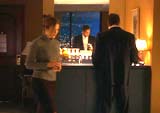  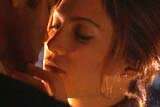 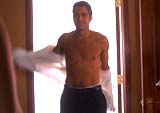
|
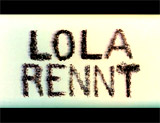
|
Run Lola Run (1998, Germ.) (aka Lola Rennt) d. Tom Tykwer In this relentlessly-thrilling, exhilarating hit film, there were three breath-taking and frenetic attempts (all "what-if" scenarios of repeating the past), largely shot in real time, of short red-haired, tattooed Lola (Franke Potente) running to help her dependent petty criminal-boyfriend Manni (Moritz Bleibtreu). Reportedly, the spectacularly fast-paced film had 1581 cuts, averaging out to 2.7 seconds per shot. In each instance, she ran and acquired replacement cash of 100,000 Deutschmarks in 20 minutes so that he didn't have to rob a supermarket - and suffer the fateful consequences. He was panicking at a yellow phone booth in Berlin, where he was to meet his boss Ronnie (Heino Ferch) at noon (in about 20 minutes) with the cash, but he had inadvertently left the bag of cash on the subway car, where it was picked up by a bum. The film's clever twist was that she was off by only a matter of seconds each time, drastically altering the consequences.
The story ended happily, but only after two earlier attempts had very different outcomes (in the first two cases, robberies of money led to death). The credits scrolled from top to bottom Also notable was the film's techno/industrial soundtrack and the use of a mix of visual styles. |
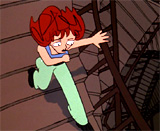 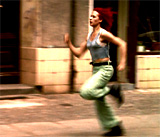 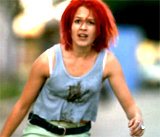 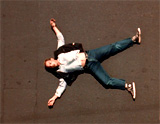 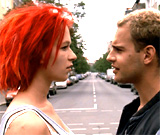
|
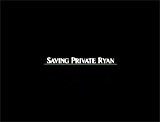
|
Saving Private Ryan (1998) d. Steven Spielberg
Steven Spielberg's WWII war drama opened, after a short prologue, with a harrowing, graphically-visceral 25-minute depiction of the Allied landing on D-Day on Omaha Beach (June 6, 1944). Its vivid opening sequence of the blood-bath attack was documentary-styled cinema verite at its finest (with hand-held cameras and special-effects shots), based on actual veterans' accounts of their experiences, and using film that deliberately bleached out colors to make it appear like a newsreel. The frantically-edited, immersive scene, to accentuate the terror and chaos and the tremendous number of casualties, began with a view of one of the soldier's trembling hands as his PT boat approached the landing area of the beachhead, revealing him to be veteran Captain John Miller (Tom Hanks in an Oscar-nominated role). One soldier vomited, and another kissed his crucifix. Miller told his nervous platoon that was squatting down and readied for landing the craft: "We'll see you on the beach." The sequence showed the grisly horrors of war as they dropped the PT's ramp and some soldiers jumped over the side into the ocean to escape the gunfire - the first wave of soldiers leaving the boats were instantly shot down as the camera jerked around, revealing that there was nowhere to hide. Bullets struck bodies underwater, legs were blown off, soldiers were incinerated by an exploding flamethrower, a grunt carried his own severed arm, and one man held onto his own pile of bloody intestines (crying: "Mama! Mama!") etc. The segment was accompanied by the loud sounds of ricocheting bullets, explosions, and grenades as the German troops in bunkers and machine gun nests fired relentlessly at the unprotected soldiers who had little cover. For a few disorienting moments, Miller was shell-shocked and lost his hearing from loud shrapnel (as the soundtrack went blank). Also, while he dragged a wounded fellow soldier, a bomb struck and took off the lower-half of the man's body, signifying how helpless the soldiers were and how battle deaths were very violent. |
 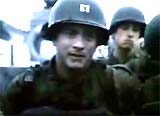 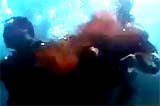 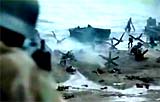 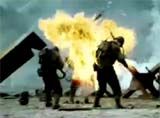 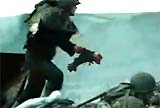 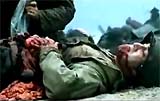
|
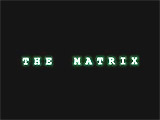
|
The Matrix (1999)
The Matrix became best known for its phenomenal and revolutionary visual effects - airborne kung fu, 3-D freeze frame effects with a rotating or pivoting camera, and bullet-dodging ("bullet-time" and "Flo-Mo"). This action film became a smash hit, featuring elaborate fighting and stunt sequences with complex editing. In the main fight-training sequence, computer programmer Thomas Anderson/Neo (Keanu Reeves) was first trained in various combat skills and martial arts via downloads (Jujitsu, Kempo, Tae Kwon Do, Drunken Boxing, etc.) through a plug-in jack at the back of his head. Then, in a highly-choreographed sequence filmed with multiple cameras and requiring intensive film editing, Neo personally battled within a kung-fu sparring program against Morpheus (Laurence Fishburne) in a virtual reality environment similar to the Construct. In the matchup, Neo was shown how he possessed super-human abilities, could break some programming rules, and could bend others, i.e., the laws of physics. He realized he could free his mind and perform impossible feats of physicality. The pace of the scene was set by the various lengths of film spliced or edited together. |
  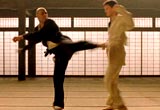 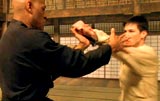 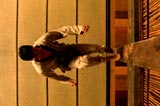 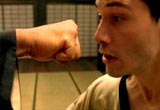
|